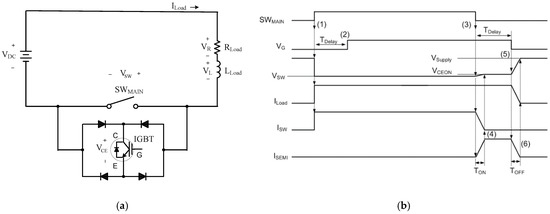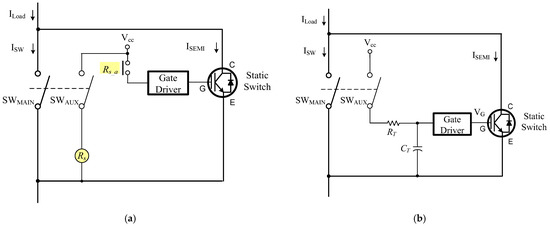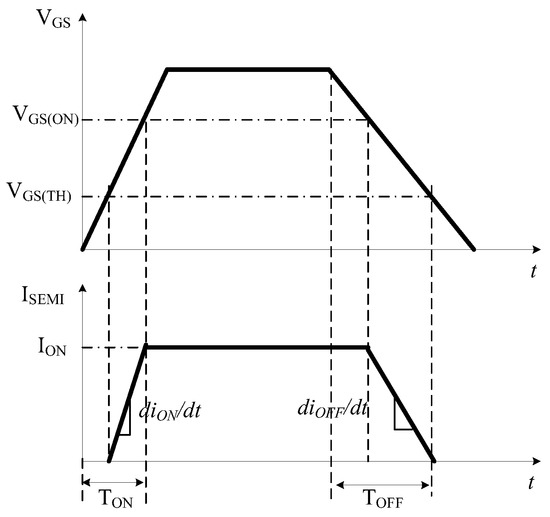One of the hurdles in the LVDC distribution system is arc flash at the contact points that occurs during the circuit is opening. Unlike alternating current, direct current has no zero points and sustains constantly. Through 400V class LVDC cutoff test, the operation of the proposed hybrid circuit breaker is verified and the characteristics are analyzed.
- low voltage DC (LVDC)
- hybrid circuit breaker
- conduction loss
- arcless
- gate drive control
1. Introduction
With the advent of electronic products in recent decades, the devices that we use have changed to work with direct current (DC) such as multimedia and mobile equipment, LED lighting, IT equipment, and electric vehicles. Moreover, in recent years, washing machines, refrigerators, fans, and heating/cooling systems adopt electric motors driven by DC power, improving speed control and energy efficiency. With the proliferation of renewable energy power systems using solar and wind energy, the form of power generation is also shifting to DC. With the latest improvements in battery technology, direct current has also become a widely recognized basic form of charge/discharge energy. Along with such outstanding technological advancement, the significant reduction in the cost of DC equipment has led to the expansion of the low voltage DC (LVDC) power distribution systems [1,2,3,4,5][1][2][3][4][5]. There are many benefits of DC compared with AC. For example, the peak voltage of DC is smaller than AC, so that the insulation is easy and larger power can be supplied with the same size of cable. There is no synchronization issue in DC, because DC has no frequency nor phase, so that management is easy. For DC loads, DC feed system is more efficient and low cost [6].
However, in order to widely spread the LVDC distribution systems, safety technologies for protecting human bodies and equipment from accidents are required. One of the distinctive features to ensure the safety of the DC system compared to the AC system is the arc phenomenon at the contact points that occurs when the mechanical switch is opened. Mechanical switches make or break electrical connection through two electrodes (fixed electrode and moving electrode). When the two electrodes are connected, switched-on contact resistance should be low enough to flow load current freely. When the two electrodes are disconnected, switched-off insulation resistance should be high enough to separate the load from electrical source. Thus, mechanical switches move around two extreme states during switching on and off, which cause severe electrical transient state.
As the electrodes are separated during the mechanical switch shutoff, the arc voltage, generated between the electrodes, causes a breakdown phenomenon in the air gap and induces a plasma arc current to cause the electrodes may be melted and stuck together [7,8][7][8]. If the mechanical switch is used in alternating current, the arc current itself becomes zero every half cycle. Therefore, if the gap between the two electrodes is sufficient, the isolation operation is easily performed by securing insulation. However, in the case of DC, there is no current zero point, so additional responsibility is required for the switch to reduce the load current to zero. To this end, an arc voltage higher than the power supply voltage must be formed across the electrodes of the DC switch. The high arc voltage formed on the electrodes increases the forces of the breaking arc and makes extinguishing the arc difficult. If the switch fails to extinguishing the arc current and fails to switching off, a high-temperature, high-pressure plasma arc current will cause a fire in the vicinity, and result in loss of life and property [9,10][9][10]. Therefore, there is a risk of electric fire due to continuous generating arcs when the load current is interrupted with an existing electrical contact type circuit breaker [11,12,13,14,15][11][12][13][14][15].
On the other hand, a switch using a semiconductor has the advantage of not accompanying an arc when the circuit is cut off, but there is a problem that the loss is large during conduction mode. Recently, the concept of a hybrid circuit breaker that takes advantages of the electrical contact type switch and the semiconductor switch has been proposed, but how to cooperatively operate the two switches has become an important issue [16].
2. Principle and Power Circuit of Proposed Hybrid Circuit Breaker
Figure 1 shows the power circuit structure and breaking arc test waveform of a LVDC system with a pure contact type switch. The contact type switch has very low conduction loss and has been widely used as an AC switch. However, since there is no current zero point in DC, it is highly probable that an arc is generated for a very long time when breaking off as shown in Figure 1b, resulting in damage to personnel and equipment due to melting or strong heat of the contact point.

In Figure 1b, the rising waveform with time is the arc voltage that occurs between the contacts when breaking off, and the falling waveform is the arc current that penetrates the air between the contacts when breaking off. At the moment the contacts are opened, the load current tries to flow by forming an electric discharge path between the contacts. Electric discharge is classified into dark discharge, glow discharge, and arc discharge according to the magnitude level of the discharge current, and arc discharge occurs when the load current is 0.5 to ~1 A or more.
In order to generate an arc discharge, the arc initiating voltage of about 10 V is rapidly formed between the contacts, because a voltage to cause plasma generation by collision of electrons and air molecules is required [17]. On the contrary, the load current satisfies Kirchhoff’s voltage law as a current drop corresponding to the arc initiating voltage between the contacts at the moment when an arc initiates. Thus, when a power semiconductor switch with a turn-on-voltage drop of under the arc initiating voltage is connected in parallel to both ends of the electrical contact, the current flowing through the electrical contact is immediately bypassed to the semiconductor switch due to the arc initiating voltage (around 10 V) generated when the electrical contact is opened.
Figure 2 shows the concept of the proposed LVDC hybrid circuit breaker using this principle. Figure 2a shows the concept of the power circuit of the proposed LVDC hybrid circuit breaker. Here, VSW is the voltage across the mechanical switch, VCE is the voltage across the static switch, VG is the gate voltage of the static switch, VR is the voltage drop across the load resistor, and VL is the voltage drop across the load reactor. The bridge diode permits the load current flows to be bidirectional. Figure 2b shows the basic operation sequence of the proposed LVDC hybrid circuit breaker.

The operation sequence of the proposed LVDC hybrid circuit breaker is as follows;
Switch ON operation sequence:
- (1) Turn on the electrical contact type main switch (SWMain).
- (2) After a certain time delay, the semiconductor switch (IGBT) is turned on by giving an ON command to the gate of the semiconductor switch. At this time, when the electrical contact type main switch (SWMain) is turned on, the voltage (VCE) between the collector and emitter terminals of the semiconductor switch is almost zero. Thus, the semiconductor switch cannot be turned ON and the load current flows through the main switch. This means that the semiconductor switch is in a standby state.
Switch OFF operation sequence:
- (1) On the standby state where the ON command is given to the gate of the semiconductor switch, the electrical contact type main switch (SWMain) is turned off.
- (2) According to the arc generation principle, when the electrical contact type main switch is turned off, an arc voltage of about 10 V is about to be formed at both ends of the contact right before the arc occurs [12].
- (3) Since the voltage reaches enough to turn on the semiconductor switch (around 2 V) before the arc initiating voltage (around 10 V) is formed, the current flowing through the electrical contact type main switch is immediately commutated to the semiconductor switch that has already given the ON command to the gate.
- (4) When the electrical contact type main switch is sufficiently opened to secure the insulation distance, an OFF command is given to the gate of the semiconductor switch to turn it OFF without generating a breaking arc.
As described above, the proposed LVDC hybrid circuit breaker has high conduction efficiency because current flows through the lossless contact points during ON state, and does not generate arcs at both ends of the contact points because semiconductor switch commutates and breaks the load current during OFF operation.
3. Gate Drive Control for Hybrid Circuit Breaker
The concept of a gate drive control circuit for the LVDC hybrid circuit breaker proposed in Figure 3 is explained. The electrical contact type switch consists of two pairs of switches: the main switch (SWMain) and the auxiliary switch (SWAux). A time delay circuit in the auxiliary switch branch operating in parallel with the main switch delays the ON/OFF command applied to the gate of the semiconductor switch (IGBT). As for the time delay circuit, a timer relay can be used as shown in Figure 3a, or a time delay by RC circuit as shown in Figure 3b can be used.

Figure 4 shows the concept of ON and OFF characteristics of a voltage-driven semiconductor switch. In voltage-driven semiconductor switches such as IGBTs and power MOSFETs, the state of the switch is determined by the magnitude of the voltage applied to the gate. As shown in Figure 4, when the voltage applied to the gate is between zero and the threshold voltage value (VGS(TH)), it does not conduct. When the voltage applied to the gate exceeds the threshold value (VGS(TH)), it starts to ON, load current also starts to increase. When the gate voltage exceeds fully turn on value (VGS(ON)), it is completely ON and 100% of the load current flows. Therefore, as shown in Figure 4, if the voltage applied to the gate (VGS) is gradually increased or gradually decreased, a time delay occurs during ON or OFF.

On the other hand, the RC circuit charges and discharges as shown in Figure 5a,b as the output of the gate driver changes to a high state voltage (Vcc) and a low state voltage (0 V). During the charging process in Figure 5a, the time it takes for the voltage across the capacitor (VCT) to reach 64% of the final high state voltage (Vcc) is equal to the time constant (τ = RTCT) of the RC circuit. For example, if the threshold value (VGS(TH)) of the gate voltage for turning ON the voltage-driven semiconductor switch (IGBT) is at 50% of the high state voltage (Vcc), the switch ON time delay (TON_Delay) of this semiconductor switch will be a little smaller than the time constant (τ = RTCT) of the RC circuit.

Conversely, the time it takes for the voltage across the capacitor (VCT) to reach 36% of the high state voltage (Vcc) during the discharging process in Figure 5b is equal to the time constant (τ = RTCT) of the RC circuit. For example, if the threshold value (VGS(TH)) of the gate voltage for turning OFF the voltage-driven semiconductor switch is at 50% of the high state voltage (Vcc), the switch OFF time delay (TOFF_Delay) of this semiconductor switch will be a little smaller than the time constant (τ = RTCT) of the RC circuit. Anyway, if the threshold value (VGS(TH)) of the gate voltage for turning on the voltage-driven semiconductor switch is set to be between 36% and 64% of the high state voltage (Vcc), the switching time delay of the semiconductor switch (IGBT) can be created in the vicinity of τ = RTCT. The time constant of the RC circuit is effective in making a short time delay of several ms in the semiconductor switch.
Figure 6 shows the mechanical components of the interlock switch that can be used as another method of implementing the operation of the proposed LVDC hybrid circuit breaker as a mechanical interlock switch. The proposed mechanical interlock implements a mechanical interlock of the main switch and the auxiliary switch by using one slider and two toggle switches. The main switch and the auxiliary switch are fixed to the frame, and the slider moves up and down linearly by external manipulation. The slider has two channels for turning each toggle switch ON/OFF, and each channel has two thresholds for turning each toggle switch ON or OFF. As shown in Figure 6, the lengths of the channel of the main switch and that of the auxiliary switch are different, so when turning on/off each toggle switch by moving the slider up and down, there is a difference in operating time of each switch. In other words, there is a delay in the ON/OFF operation of the two switches as much as the backlash depth shown in Figure 6. For example, when the backlash distance is 10 mm and the manipulation speed of the slider is 1 m/s, there is 10 ms of time delay between the main switch and the auxiliary switch.

In the case of the switch ON sequence, both the main switch and the auxiliary switch are in the OFF state in the initial condition (SWMain = OFF/SWAux = OFF). When the slider moves down and comes to state 1, as in Figure 6b, the main switch is first turned ON, but the auxiliary switch is still in the OFF state (SWMain = ON/SWAux = OFF). When the slider moves further down and comes to state 2, as in Figure 6c, both the main and auxiliary switches are turned on (SWMain = ON/SWAux = ON). Through this operation, a time delay is implemented by mechanical interlocking of the main switch and the auxiliary switch. This method of time delay by mechanical interlock may be applied to a simple structure wall mounted switch.
References
- Pratt:, A.; Kumar, P.; Aldridge, T.V. Evaluation of 400V DC distribution in telco and data centers to improve energy efficiency. In Proceedings of the 29th International Telecommunications Energy Conference INTELEC 2007, Rome, Italy, 30 September–4 October 2007; pp. 32–39.
- Babasaki, T. Developing of Higher Voltage Direct-Current Power-feeding Prototype System. In Proceedings of the INTELEC 2009—31st International Telecommunications Energy Conference, Incheon, Korea, 18–22 October 2009; pp. 1–5.
- Rodriguez-Diaz, E.; Vasquez, J.C.; Guerrero, J.M. Intelligent DC homes in future sustainable energy systems: When efficiency and intelligence work together. IEEE Consum. Electron. Mag. 2016, 5, 74–80.
- Dragicevic, T.; Vasquez, J.C.; Guerrero, J.M.; Skrlec, D. Advanced LVDC electrical power architectures and microgrids: A step toward a new generation of power distribution networks. IEEE Electrif. Mag. 2014, 2, 54–65.
- Ghaffarpour Jahromi, M.; Mirzaeva, G.; Mitchell, S.D.; Gay, D. Powering mobile mining machines: DC versus AC power. IEEE Ind. Appl. Mag. 2016, 22, 63–72.
- Whaite, S.; Grainger, B.; Kwasinski, A. Power Quality in DC Power Distribution Systems and Microgrids. Energies 2015, 8, 4378–4399.
- Tsuruta, K.; Yanagi, K.; Shibata, S.; Yanagidaira, T.; Ikehata, T. Effect of axially symmetric magnetic fields for dynamics of low-current DC vacuum arc plasma. IEEE Trans. Plasma Sci. 2007, 35, 959–965.
- Zhu, L.; Ji, S.; Liu, Y. Generation and developing process of low voltage series dc arc. IEEE Trans. Plasma Sci. 2014, 42, 2718–2719.
- Lee, S.; Kim, D. A study on Low-Voltage DC circuit breakers. In Proceedings of the IEEE International Symposium on Industrial Electronics (ISIE), Taipei, Taiwan, 28–31 May 2013.
- Jadidian, J. A compact design for high voltage direct current circuit breaker. IEEE Trans. Plasma Sci. 2009, 37, 1084–1091.
- Kim, H. DC distribution systems and circuit breaking technology. J. Korean Inst. Power Electron. 2010, 15, 40–46.
- Beak, S.; Yuba, T.; Kiryu, K.; Nakamura, A.; Miyazawa, H.; Noritake, M.; Hirose, K. Development of plug and socket-outlet for 400 volts direct current distribution system. In Proceedings of the 8th International Conference on Power Electronics—ECCE Asia, Jeju, Korea, 30 May–3 June 2011; pp. 218–222.
- Lee, S.; Kim, H. Development of DC Circuit Breaker using Magnet Arc Extinguisher. Trans. Korean Inst. Power Electron. 2012, 17, 21–26.
- ABB Circuit-Breakers for Direct Current Applications. 2007. Available online: (accessed on 20 January 2021).
- Strobl, C.; Kopf, H.; Mehl, R.; Ott, L.; Kaiser, J.; Gosses, K.; Schafer, M.; Rabenstein, R. Safety Concepts and Circuit Protection for LVDC Grids in Datacenters and in Telecommunications. In Proceedings of the 2018 IEEE International Telecommunications Energy Conference (INTELEC), Torino, Italy, 7–11 October 2018.
- Shukla, Z.A.; Demetriades, G.D. A survey on hybrid circuit-breaker topologies. IEEE Trans. Power Del. 2014, 30, 627–641.
- Kim, W.H.; Kim, Y.J.; Kim, H.S. Arc Voltage and Current Characteristics in Low-Voltage Direct Current. Energies 2018, 11, 2511.
